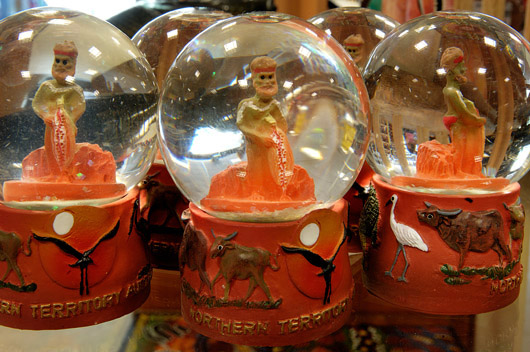A.bc
In Australia, sulle tracce di Chatwin 20 anni dopo Le Vie dei Canti
Palazzo delle Esposizioni, Roma
A.bc
In Australia, in Chatwin's footsteps 20 years after The Songlines Palazzo
Delle Esposizioni, Rome


Una
cultura sotto vetro. Interno giorno di un negozio del centro di Darwin,
ultimi scampoli di tempo prima della partenza, momenti per i souvenir.
Tra magliette che riproducono i must dell’Australia Down Under e
maschere della Papuasia o addirittura africane, su una vetrinetta accanto
alla cassa spunta una serie di palle di vetro con la neve dentro. Made
in China, come cinesi sono le commesse, tanto per ribadire che si è
sulla frontiera australo-asiatica. Solo che al posto di San Pietro o della
Tour Eiffel c’è un canguro o un aborigeno in costume rosso
e uno scudo in mano. Gli aborigeni sotto vetro, un’immagine emblematica.
Da una parte, c’è un sistema complesso di norme che li protegge
ma allo stesso tempo li ghettizza, che registra progressivi aggiornamenti
(in vista delle prossime elezioni di novembre il governo Howard, storicamente
insensibile alla questione indigena, ha improvvisamente proposto di inserirli
come “i primi australiani” nel preambolo della Costituzione).
Dall’altra, gli aborigeni rappresentano una risorsa turistica, come
i canguri o Uluru Ayer’s Rock, da valorizzare, sfruttare, vendere.
Per Chatwin erano un richiamo culturale. Le loro piste del sogno, la loro
Tjuringa, i cammini percorsi dagli esseri ancestrali, il rapporto con
la terra continuamente nutrito da rituali e viaggi, per rafforzare l’identità
e trasmettere energia a una terra che deve restare viva, tutto questo
è entrato a far parte de “Le Vie dei Canti”. E, seppure
con qualche forzatura - dovuta alla necessità di adattare la materia
alla sua teoria sul nomadismo - ha prodotto una narrazione potente, felice,
densa. Chatwin ha dato forza e voce a quei sogni, specchiandovisi dentro.
Nomade di fronte a (un tempo) nomadi
A showcase culture. Darwin, souvenir time. Among T-shirts that reproduce
the must of Australia Down Under and masks of Papua or even African, in
a showcase a series of snow globes. Made in China, just like the shop
assistants, as a confirmation that we are on the border with Asia. But
instead of Mickey Mouse or the Eiffel Tour there is an Aboriginal dressed
in red with a shield. Aboriginal people under glass, an emblematic image.
On the one hand, they are protected and, at the same time, marginalized
by a complex system of laws. On the other, Aboriginal people represent
a tourist resource, like kangaroos or Ayer’s Rock, to develop, exploit,
sell. For Chatwin they were a cultural call. Their dream tracks, their
Tjuringa, the paths travelled by ancestral beings, the relationship with
the earth continuously fed by rituals and travel, to strengthen the identity
and transmit energy to a land that must remain alive, all this has come
to be part of The Songlines. And, although with some effort - due to the
need to adapt the material to his theory on nomadism - has produced a
powerful, happy, dense narrative. Chatwin gave strength and voice to those
dreams, reflecting himself in them. Nomad facing (once) nomads